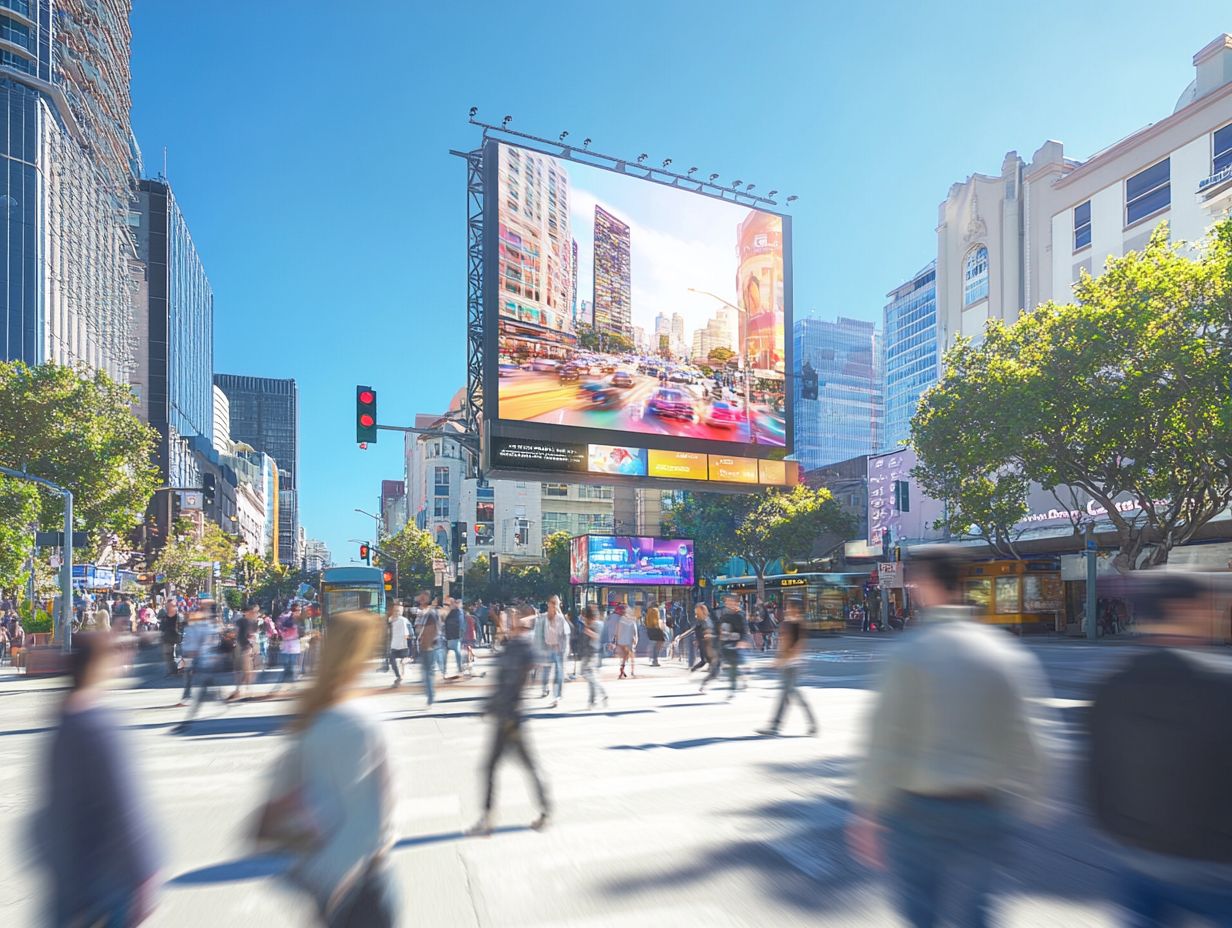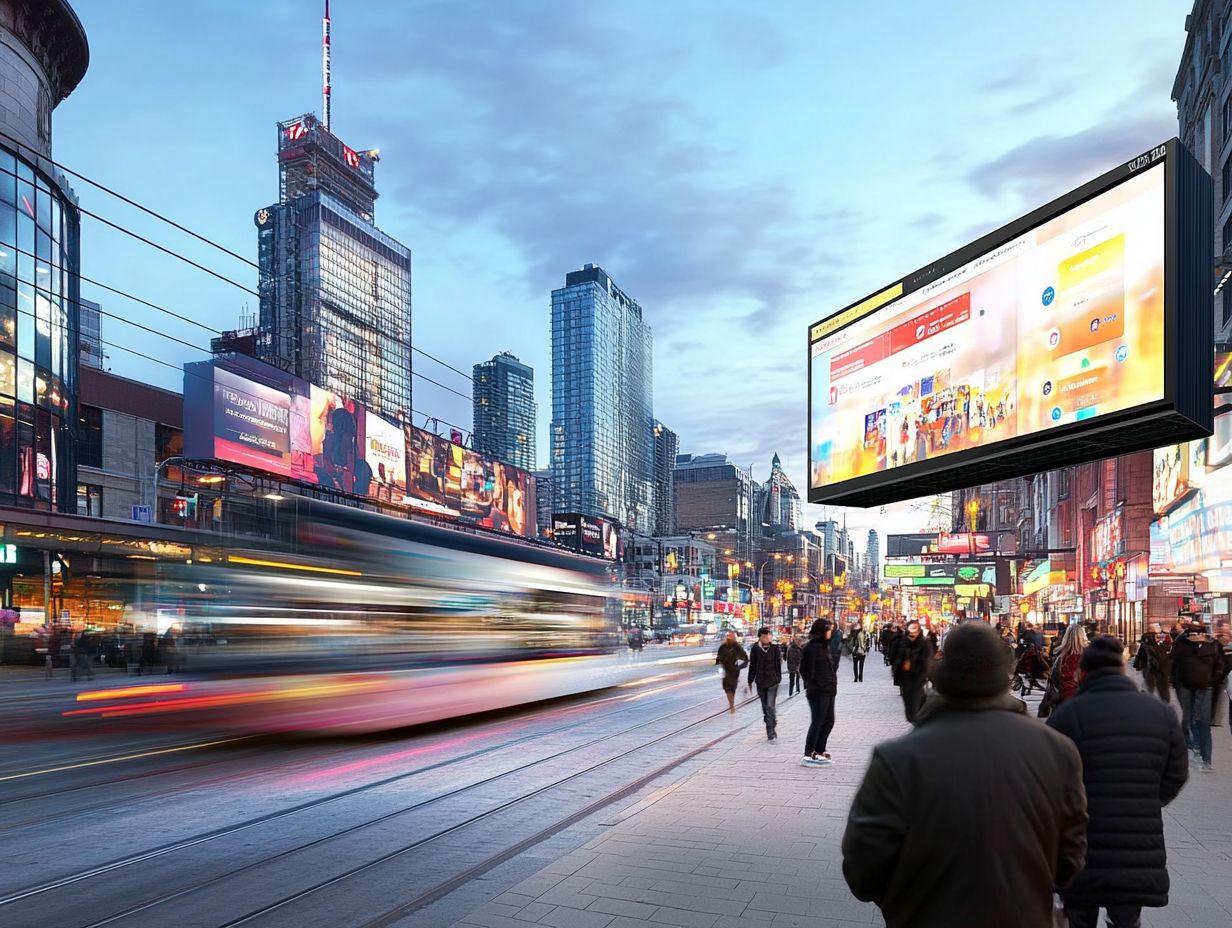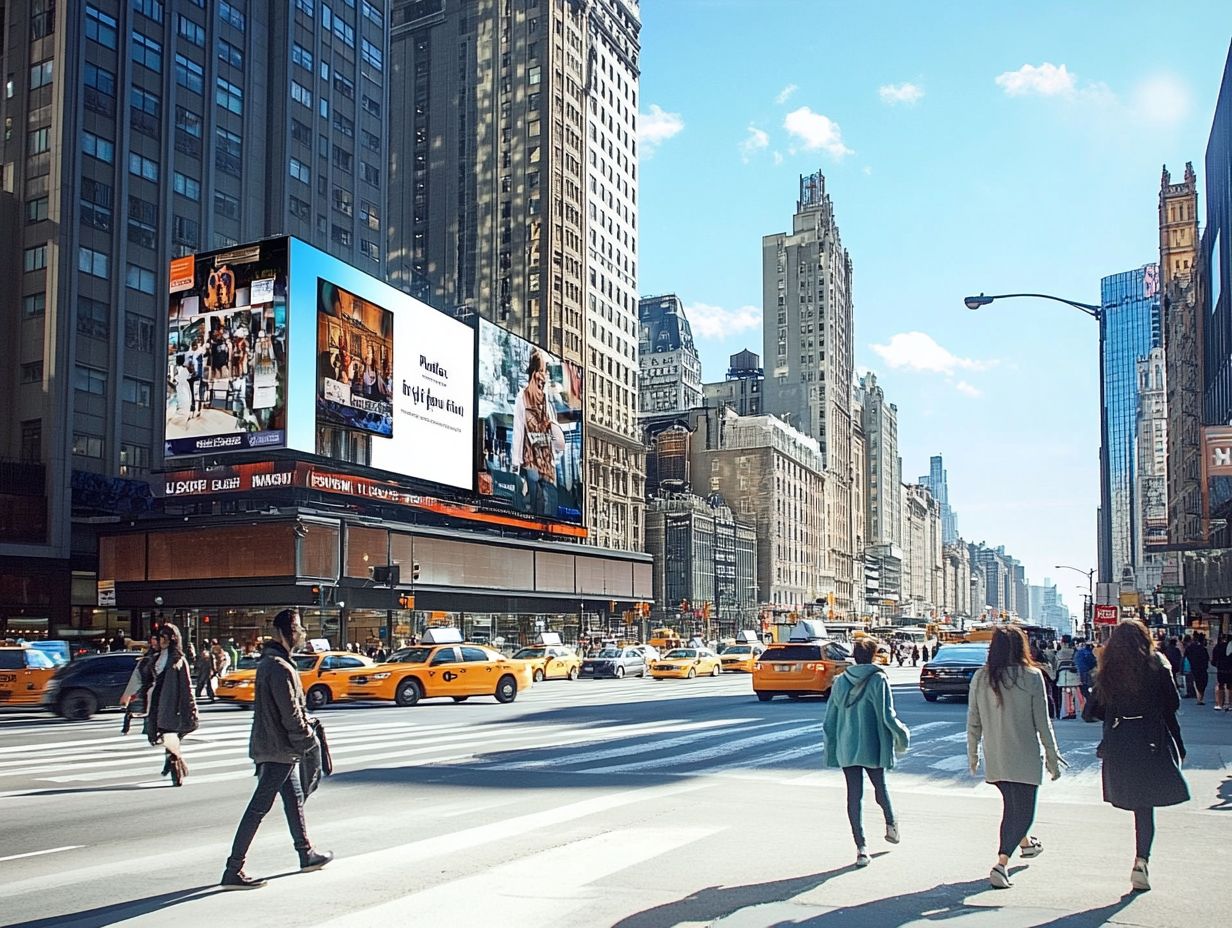Roadside billboards have long been a cornerstone of advertising, effectively capturing the attention of both drivers and pedestrians. But how can we measure their effectiveness? This article explores the crucial role that billboards play in advertising and investigates innovative methods for assessing their impact through foot traffic data. We will examine the factors that influence a billboard’s success, including location, design, and target audience, while also sharing tips for creating campaigns that maximize visibility and engagement. Join us as we reveal the secrets to making roadside billboards an asset for your brand.
The Importance of Measuring the Impact of Roadside Billboards

Measuring the impact of roadside billboards is essential for understanding their role in outdoor advertising and ensuring that marketing strategies effectively reach target audiences. This involves detailed data analytics and pedestrian traffic analysis to gauge their advertising effectiveness.
In today’s data-driven marketing landscape, brands must analyze metrics such as advertising effectiveness and brand exposure to optimize their campaigns and enhance return on investment (ROI). This includes the use of foot traffic data, location analytics, and visual communication strategies.
By implementing robust measurement strategies, businesses can gain valuable insights into visibility analysis, consumer behavior, and engagement metrics, enabling them to adjust their advertising strategies based on real-time data. This can involve impression measurement and the use of analytical models.
Understanding the Role of Billboards in Advertising
Roadside billboards significantly enhance advertising effectiveness by improving brand awareness and influencing consumer behavior when placed strategically in high-traffic locations. Effective site selection and spatial analysis are crucial for maximizing their impact.
As a vital component of outdoor advertising, they capture the attention of passing pedestrians and drivers, facilitating effective brand communication. The large visual impact of roadside billboards makes them an essential element of any advertising strategy aimed at enhancing effectiveness, including campaign optimization and strategic advertising planning.
They reach a broad audience and engage consumers during the decision-making process, proving especially effective for impulse purchases. As consumers become increasingly mobile, billboards also gain effectiveness, allowing brands to target specific demographics in geographical areas that these consumers frequently visit. This aspect of audience targeting and demographic analysis enhances advertising reach and brand recall.
Outdoor billboards not only improve visibility but also reinforce brand messaging, enabling potential customers to develop a stronger connection with products and services. Techniques such as behavior tracking and sensory perception analysis can further enhance this connection.
When combined with digital marketing initiatives, roadside billboards further enhance the overall effectiveness of advertising campaigns. This integration can be measured through advertising spend analysis and the use of digital billboards for increased engagement.
Using Foot Traffic Data to Measure Billboard Effectiveness

Foot traffic data is essential for measuring the effectiveness of roadside billboards, as it provides marketers with insights into how many people interacted with the signage and the traffic patterns surrounding each location. Effective use of this data involves traffic measurement and data collection methods such as sensor data and geolocation data.
By analyzing this data, marketers can evaluate the visibility of their billboards and determine the level of consumer engagement. This metric is crucial for location-based advertising and marketing strategies.
How Foot Traffic Data is Collected and Analyzed
Foot traffic data can be collected through various techniques, including mobile tracking, GPS analytics, and manual traffic counting.
These methods enable marketers to measure pedestrian traffic and understand customer behaviors in specific locations. For instance, mobile tracking utilizes smartphone signals to gather anonymous location data, offering a comprehensive view of visitor paths and dwell times. Additionally, the use of traffic counts and GPS analytics can offer deeper insights.
GPS analytics enhances this process by mapping footfalls with high precision, revealing peak traffic times and patterns. Although manual traffic counting is a more traditional approach, it can still provide valuable qualitative data through direct observation. These measurement techniques are integral to effective traffic flow and sign visibility analysis.
By employing these measurement techniques alongside analytics tools, marketers gain a clearer understanding of customer engagement, allowing them to tailor their messaging and promotions to match specific audience insights, ultimately driving higher conversion rates. This process is enhanced through the use of data visualization and behavior analysis techniques.
Factors Affecting the Impact of Roadside Billboards

The impact of roadside billboard advertising is influenced by various factors that contribute to its overall effectiveness, including billboard location, design, and the target audience. Strategic billboard placement and visual advertising techniques are key components of this strategy.
Understanding these elements can help marketers optimize their advertising campaigns to achieve maximum visibility and engagement rates. This involves a thorough ROI assessment and the use of marketing metrics to track advertising performance.
Additionally, seasonal effects and competitive analysis are important factors to consider when measuring the effectiveness of roadside billboard advertising. Organizations should evaluate these aspects as part of their advertising strategy, incorporating market research and media planning for better results.
Location, Design, and Target Audience
The effectiveness of roadside billboards hinges on three key factors: location, design, and understanding the target audience. Selecting the right location can significantly enhance the visibility and reach of a brand. Meanwhile, effective design elements ensure that the messaging resonates with consumers. Accurate traffic analysis and location intelligence are crucial for determining optimal billboard placement.
When brands align their advertising strategies with consumer insights and preferences, they can maximize the visual impact of their billboard campaigns and achieve greater engagement. Strategic audience measurement and insight generation are essential for this alignment.
Choosing the optimal billboard location involves more than simply placing it on a busy road; it requires an analysis of traffic patterns, demographics, and the surrounding environment. A location that captures the attention of drivers and commuters during peak hours will result in a higher impression rate. This form of site selection is informed by spatial analysis and market segmentation.
Likewise, the design should be eye-catching yet straightforward, employing high-contrast colors and concise text to convey messages quickly and effectively.
Brands must also consider the specific preferences and behaviors of their target audience to create content that resonates with them on an emotional level. A strategic approach to these factors will enable advertisers to establish a strong presence, ultimately enhancing awareness and conversion rates. Effective use of audience targeting relies on thorough demographic analysis and consumer outreach.
Maximizing the Effectiveness of Roadside Billboards

To maximize the effectiveness of roadside billboards, a comprehensive approach is essential, incorporating campaign optimization, strategic messaging, and compelling billboard design. This also involves continuous measurement techniques and marketing effectiveness analysis.
By prioritizing the enhancement of advertising performance and consumer engagement, brands can ensure that their billboards achieve significant results. Effective ROI assessment and impression tracking are key components of this process.
Additionally, implementing effective marketing strategies that align with audience preferences and behaviors can lead to greater signage impact and a higher return on investment. This involves leveraging business intelligence and real-time data analysis to inform decision-making.
Tips for Creating Effective Billboard Campaigns
Effective billboard campaigns require careful consideration of design, messaging strategy, and the integration of consumer insights to enhance advertising visibility. Incorporating market research and advertising spend analysis can further refine these campaigns.
To achieve the highest engagement rates, successful billboard campaigns align with current advertising trends, ensuring that the design captures the audience’s attention while clearly conveying the advertisement’s intent in a brief moment. Utilizing advertising research and audience targeting can significantly enhance campaign performance.
This involves using bold colors and images that resonate with the target demographic, alongside a concise and impactful tagline that can be read quickly. Advertisers can leverage a deep understanding of consumer behavior through data analysis to create content closely related to specific audiences, thereby increasing the likelihood of interaction. Effective use of geolocation data and advertising reach metrics can further enhance these efforts.
Conducting A/B testing with different designs and messages can provide valuable metrics on what resonates best with viewers. As trends evolve, staying updated with new technologies such as digital billboards and mobile integration can further enhance outreach and engagement, making each campaign not only eye-catching but also effective in achieving its desired outcomes. Effective use of advertising trends and data-driven decisions are integral to this process.





